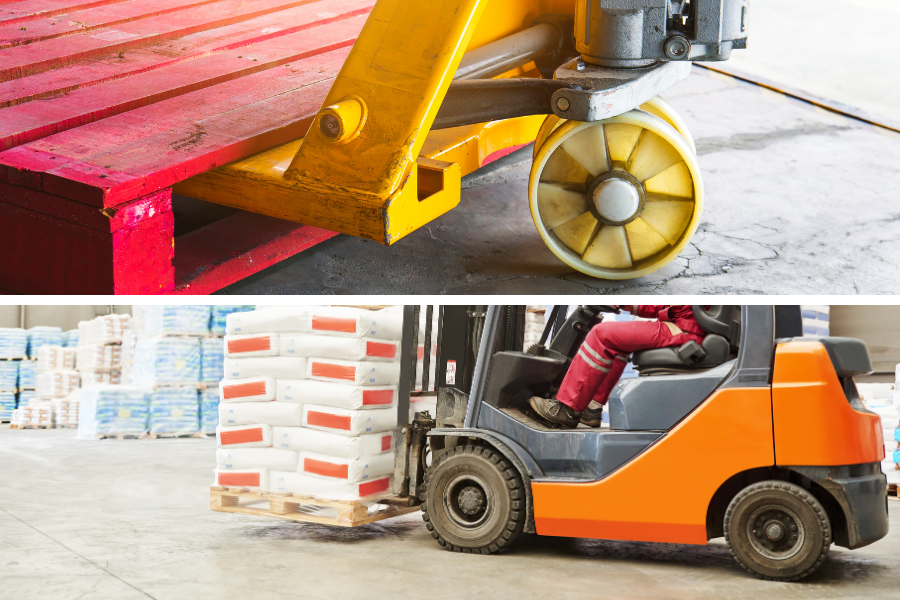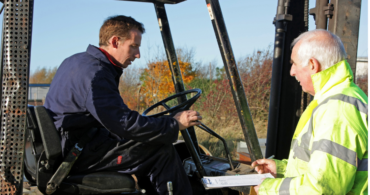In this corner, we have the heavyweight of lifting, weighing in at an average 3,000-5,000 pounds: the forklift. In the opposite corner, the nimble roller, the agile angler: the pallet jack.
Welcome to the third article in our no-holds-barred series comparing the lifting machines in our lives. The first epic duel featured the battle of the telehandler vs forklift, the second saw the scuffle of the reach truck vs forklift and today we’re turning our attention to the conflict of the pallet jack vs forklift.
Alright, the machines have shaken, uh, forks and returned to their corners. We’re ready to begin.
Round 1 Pallet jack vs forklift: What are they?
What’s a forklift?
A counterbalanced forklift is the hefty truck that zooms around warehouses moving and lifting cargo. However, there are seven classifications of forklifts, and a forklift and pallet jack each fall under one of those classifications (counterbalanced forklifts are class I, while pallet jacks are class III).
So, the answer to “What is a forklift?” is complex, extensive and ranges from the tiny trucks that zip through storage racks to the giant beasts that operate outdoors. However, in this fight, “forklift” refers to the standard counterbalanced lift.
The counterbalanced forklift has been a staple in warehouses for decades, boasting power and versatility. It typically has four wheels (although some have three) that are usually cushion (solid), although some have pneumatic (air-filled) tires. The vehicle’s most prominent feature is the forks attached to the truck’s mast. Most pallet forklifts can reach up to 14 feet, although some specialized masts can double the reach.
What’s a pallet jack?
Compared to a forklift pallet jacks are much simpler machines that trade the size and strength of a counterbalanced forklift for maneuverability. It’s about a fourth of the size and weight of a forklift. A standard pallet jack can lift about 7,500 pounds on average. Most are battery-powered; however, there are manual options.
For a manual pallet jack, an operator lifts cargo by pulling a lever back and forth, using it like a jack.
An electric pallet jack, also known as an EPJ forklift, is usually designed with a platform in the middle where the operator stands. However, some omit the platform, so the operator walks behind the machine, while others, known as walkie riders, provide the choice of steering while walking behind or riding on a small platform.
Pallet jacks are designed for easy navigation in confined spaces and typically feature a pair of small wheels at the front near the forks and a pair of larger wheels at the rear. The front wheels provide maneuverability, while the larger rear wheels support the weight of the machine and its cargo. The operator steers by maneuvering a handle, efficiently navigating narrow aisles and crowded storage areas.
To lift cargo, the operator guides the forks through a pallet and then engages the hydraulic system, causing the forks to rise. Most pallet jacks only lift their cargo high enough to move.
Round 2 Forklift vs pallet jack: Maneuverability
In Oct. 1974, George Foreman and Muhammad Ali faced off in what was billed as “The Rumble in the Jungle.” Despite his skill and success, no one gave Ali much of a chance because of Foreman’s size and experience. However, Ali emerged victorious with a knockout in the eighth round, primarily due to his skill and speed.
In our pallet jack fork lift showdown, the pallet jack takes the maneuverability round due to its smaller size and turning radius. Granted, for as big as they are, forklifts are remarkably nimble, especially the three-wheeled models. However, they cannot compete with the compact design of a pallet jack.
Round 3 Pallet jack vs forklift: Versatility
The standard forklift is capable of impressive lifting feats. Additionally, a forklift with pallet attachments expands its capabilities and versatility, such as:
- Fork extensions: increase the fork’s length to handle longer loads.
- Side shifters: enable an operator to move the forks laterally left and right.
- Fork positioners: adjust the distance between the forks to accommodate various pallet sizes.
- Clamps: allow forklifts to handle irregularly shaped loads, such as barrels, drums and items that don’t fit on pallets.
- Rotators: let forks turn to transfer loads into other containers.
- Buckets: transform the machine into a scoop or sweep.
- Platforms and cages (and some buckets): create mobile elevated work platforms.
- Fork hooks: allow a forklift to carry containers that have eyelets, straps or other designated lifting points.
Pallet jacks cannot provide this level of diversification. They are simple and efficient lifting and moving machines. A forklift is the obvious winner for businesses that need more than that.
Round 4 Pallet jack vs forklift: Space efficiency
Obviously, a forklift takes up much more space than a pallet jack, not just in the size of the vehicle but also in the area necessary to store it and its accessories. However, this larger frame gives the machine greater lifting capacity, a higher reach, the ability to cross large distances quickly and the capacity for many different attachments.
A pallet jack is a much smaller vehicle, making it better suited for smaller warehouses or simple jobs. The frame of a pallet jack means it requires less space to maneuver and store.
Ultimately, the victor in the pallet jack vs forklift confrontation comes down to the end user’s needs. Both a forklift and pallet jack are excellent machines. However, if you have a larger warehouse with multiple storage levels, a forklift is likely the best machine for you. If you have a smaller space with floor storage, a pallet jack is likely the right solution.
The one thing an electric forklift and pallet jack have in common is that they need to get the most out of their batteries. That’s where Texas Motive Solutions can help. Our complimentary forklift fleet performance analysis ensures that you will have the best batteries for your needs. Please give us a call at (888) 316-2459 or fill out this form to begin a service request and discover everything we can do for you.


